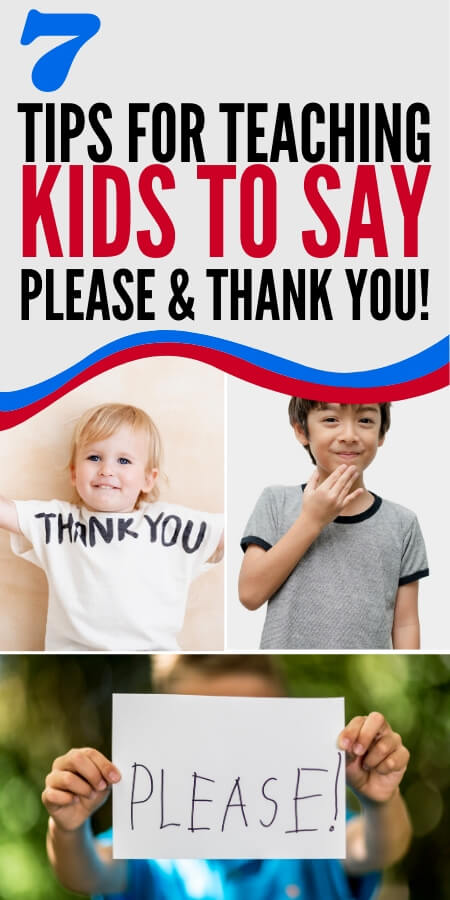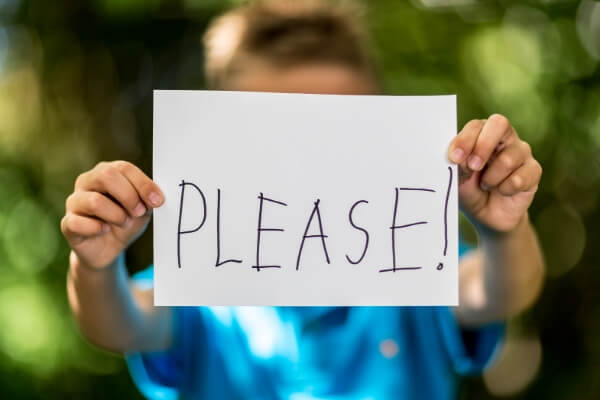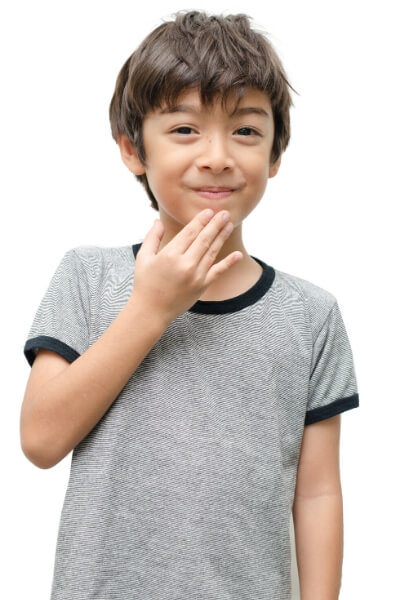If you have kids you know it can be a constant struggle to get them to use good manners. Here’s how to teach your child to say please and thank you without a battle!
Our job as parents is to bring up our kids to become respectful, polite, functioning adults. And that’s a big job!
** This website contains affiliate links. If you make a purchase using one of these links, I may earn a commission. Please click here for more information about cookies collected and our privacy policy **.
Having good manners and being polite is an important part of life. Not only does it tell the person you are interacting with that they matter and are worthy of respect, but it also is a character trait that can take you far in life.
Teaching kids to say please and thank you is tough. It can feel like no matter how many times you remind them that they just don’t get it.
But in the end it’s worth it. Now I can take my 6 kids out to dinner and when the waiter comes and refills water there is a chorus of thank you, thank you, thank you as she goes around the table. And while compliments aren’t what matters, it’s nice to know that all that work put in when they were young meant something.
So how exactly do you teach your kids to say thank you and please reliably? Here are 7 tips that I used when my kids were growing up to teach and encourage politeness at all times.
7 Tips for Teaching Kids to Say Please and Thank You
Start Young
While this tip won’t help you if you are dealing with a rude tween, if you are just starting out on your parenting journey make sure you prioritize manners with your kids from an early age.
This can be accomplished a few different ways but one of the easiest is to use sign language with babies. The signs for please and thank you are very easy ones and you can train babies to use them just by using them yourself.
These signs can be used very early and since they are easier for kids to mimic. It’s a great way to give babies or toddlers who don’t have the language skills to say the words please and thank you a way to communicate and use manners.
Try to work the signs into your everyday interactions with your babies or toddlers- at meal times, when offer toys, when receiving toys, etc- just make it a natural part of your day.
Model the Language You Want
The best way to get kids to act and speak how you want? Model the behavior you want.
This mean they should see YOU saying please and thank you all the time.
Say thank you to the man holding the door for you at the library.
Say yes, please & thank you to the the waiter.
Say please pass the potatoes at the dinner table.
Say thank you! when your child offers you a mud pie in the yard.
Say May I please speak to Jane? on the telephone.
You can’t expect them to learn how to say please and thank you if you aren’t modeling that behavior. This not only shows them HOW to say it, but where as well.
Give Them the Correct Words to Use
When kids are just learning to use their manners they don’t always know exactly what they should be saying.
When my kids were very young toddlers, when they would say “more!“, I would answer with “More, please” and then give them more. Even as babies and they couldn’t really talk, but would wave their arms and say “mm…mmm…” or whatever their baby word for more was, I’d respond with more please before giving them a bite.
For babies, it helps teach them to talk and manners at the same time. For toddlers it’s helping them to see the correct way to ask for what they want.
As they got older, instead of “more please”, I would repeat a phrase they were capable of saying instead. Such as “Can I please have more bread?”
If they are old enough to understand, I made them repeat those words before giving them what they asked for.
Kids don’t inherently know the correct and polite way to make a request, and the only way to teach them is to give them the words you want to hear. And then give them a chance to use those words.
This also works for older kids who are older and might be backtalking – give them the polite words you want to hear, and give them a chance to take back their rude words and replace them with polite ones.
For thank you, it’s the same. I’d whisper can you say thank you? in their ears when they got a gift. Or mouthed the word to them from across the dinner table. These gentle reminders didn’t call them out or cause a power struggle, it just reminded them and gave the the exact words they could use at that moment.
“Excuse Me?”
This is probably the most important tool I used when teaching my kids to say please. And I trained them with it from a very young age.
Basically it goes like this:
Kid: More water!
Me: Excuse me?
Kid: More water please.
I didn’t say it in a stern tone, I just simply said “excuse me?” like I didn’t quite hear them right.
Sure the first few times I was met with blank stares for a few minutes and I might have had to prompt them a little by asking what do you say? or what’s the magic word?
But pretty quickly they understood that when I responded to a request with excuse me? They needed to say please. I think of it kinda like the manners version of the Mom Look.
Give Positive Praise
When it comes to things like teaching you child to say please and thank you, positive reinforcement is so much more effective than negative reinforcement.
It’s not at all helpful to punish a child who’s learning to use their manners for not saying please or thank you, but on the flip side, positive praise can go a long way in encouraging them to use their manners at all times.
I don’t like to give rewards, though some kids are really moved by something like a sticker chart.
Instead I like to praise them when they use their manners without being prompted.
Call them out for saying please and thank you. Give them a hug and some positive attention by saying things such as Thank you so much for being so polite! I’m so proud of you!”
Cause and Effect
While I don’t see the benefit in handing out punishments for not using manners, I do see the benefit of not rewarding rude behavior.
As kids get older, they have more control over their words and their actions. They start to assert their independence and test boundaries. And often this ends up with some manners slipping.
So while I usually give my kids the chance to redeem themselves, they also know that a rude request is responded to with a NO.
They need to learn that there is a way to ask for things and get what they want while still being polite. That there is a way to respond to requests without being rude.
So if they want to finish a video before taking the trash out and they meet my request with a rude Hold on! Not right now! then they will be taking the trash out right that minute.
If my request is met with a polite Can I please finish this before I take the trash out? then I am much more willing to grant that request.
The natural consequences of being rude are a great way to teach your kids to say please and thank you. And it’s a good life lesson that is best learned as soon as possible.
Have Patience While They Are Learning
Learning manners isn’t an overnight thing. There’s no switch you can flip and you can’t teach them once and expect them to get it right from then on.
You need to have patience with your kids. Teaching them to say please and thank you takes years of modeling and reminding and probably some tough choices and tears as well.
But if you keep at it and keep giving praise and gentle reminders eventually they will get it. And you will find yourself reminding them less and less, until one day you watch your child and smile as they interact with another person in a polite way that makes you proud.
Your May Also Like:
7 Chores Your Teens Should Be Doing on Their Own
5 Ways to Get Kids To Pick Up Their Stuff
7 Daily Routines to Add to Your Child’s Day






Simple words, but it’s hard to teach the kids to use them meaningfully! Good article, thank you!